All Management News
- Dr Goutam Kumar Dalapati develops high-performance photodetectors with improved electrical parameters November 19, 2020
 Dr Goutam Kumar Dalapati, Associate Professor, Department of Physics, SRM University-AP, Andhra Pradesh, published a research paper “Improvement on Photoresponse Properties of Self-Powered ITO/InP Schottky Junction Photodetector by Interfacial ZnO Passivation” in the reputed Journal of Electronic Materials, Springer. Photodetection has emerged as the key technology in contemporary science because of their wide range of applications in daily life and in industry, including astronomy, surveillance, environmental monitoring, machine vision, and cameras in smart phones. Commercial photodiodes should meet the criteria of high charge carrier mobility, small exciton binding energy, and higher stability. This intrigued Dr Goutam to indulge in the study of photodetector which is essential to improve several electrical parameters such as low power consumption, and higher sensitivity.
Dr Goutam Kumar Dalapati, Associate Professor, Department of Physics, SRM University-AP, Andhra Pradesh, published a research paper “Improvement on Photoresponse Properties of Self-Powered ITO/InP Schottky Junction Photodetector by Interfacial ZnO Passivation” in the reputed Journal of Electronic Materials, Springer. Photodetection has emerged as the key technology in contemporary science because of their wide range of applications in daily life and in industry, including astronomy, surveillance, environmental monitoring, machine vision, and cameras in smart phones. Commercial photodiodes should meet the criteria of high charge carrier mobility, small exciton binding energy, and higher stability. This intrigued Dr Goutam to indulge in the study of photodetector which is essential to improve several electrical parameters such as low power consumption, and higher sensitivity. In this research, Dr Goutam developed a high-performance photodetector using Indium phosphide/indium tin oxide (InP/ITO) semiconductor metal junction. He explains, “Photodetection in semiconductors follows the principle of generating electron-hole pairs under incident light higher than or equal to its bandgap. In Schottky type photodiode, at thermal equilibrium, the Fermi levels of the metal and the semiconductor are equalized, and a transfer of electronic charge occurs from the semiconductor to the metal. Moreover, these charge transport properties can be simply tailored by compositional engineering, which provides plenty of space to modulate the performance metrics of the photodetectors. During my research, the atomic layer deposition of zinc oxide (ZnO) on the InP surface was found to increase the valence band offset for current conduction in the photodiode. Photoresponse properties were believed to improve through effective hole blocking by the ZnO interface layer which further prevents the surface recombination of photo-induced generated electron-hole pair. Through my research, I deciphered that the ITO/ZnO/InP photodiode exhibited a maximum photoresponsivity of 44.2 mAW−1 under a 520 nm laser irradiation with an illumination power of 1 μW at the zero bias voltage.”
In this research, Dr Goutam developed a high-performance photodetector using Indium phosphide/indium tin oxide (InP/ITO) semiconductor metal junction. He explains, “Photodetection in semiconductors follows the principle of generating electron-hole pairs under incident light higher than or equal to its bandgap. In Schottky type photodiode, at thermal equilibrium, the Fermi levels of the metal and the semiconductor are equalized, and a transfer of electronic charge occurs from the semiconductor to the metal. Moreover, these charge transport properties can be simply tailored by compositional engineering, which provides plenty of space to modulate the performance metrics of the photodetectors. During my research, the atomic layer deposition of zinc oxide (ZnO) on the InP surface was found to increase the valence band offset for current conduction in the photodiode. Photoresponse properties were believed to improve through effective hole blocking by the ZnO interface layer which further prevents the surface recombination of photo-induced generated electron-hole pair. Through my research, I deciphered that the ITO/ZnO/InP photodiode exhibited a maximum photoresponsivity of 44.2 mAW−1 under a 520 nm laser irradiation with an illumination power of 1 μW at the zero bias voltage.”For the successful implementation of the proposed ITO/ZnO/InP photodiode in the manufacturing levels, significant efforts are essential. Dr Goutam acknowledges that device to device variability must be addressed which arise from the deposition condition of the ZnO layer by atomic layer deposition. Surface defects reduction and selection of charge collecting electrodes must be optimized to improve the performance of the photodetector. Thus, Dr Goutam will dedicate his future research work to study patterned 2D graphene-based electrode to improve the performance. Also, n-type 2D MoS2 and hexagonal boron nitride (hBN) passivation will be studied by him on the III-V semiconductor surface for better photoresponsivity.
Continue reading → - Sub-Post Office at SRMAP November 18, 2020
The Hindu Nov-18
Continue reading →
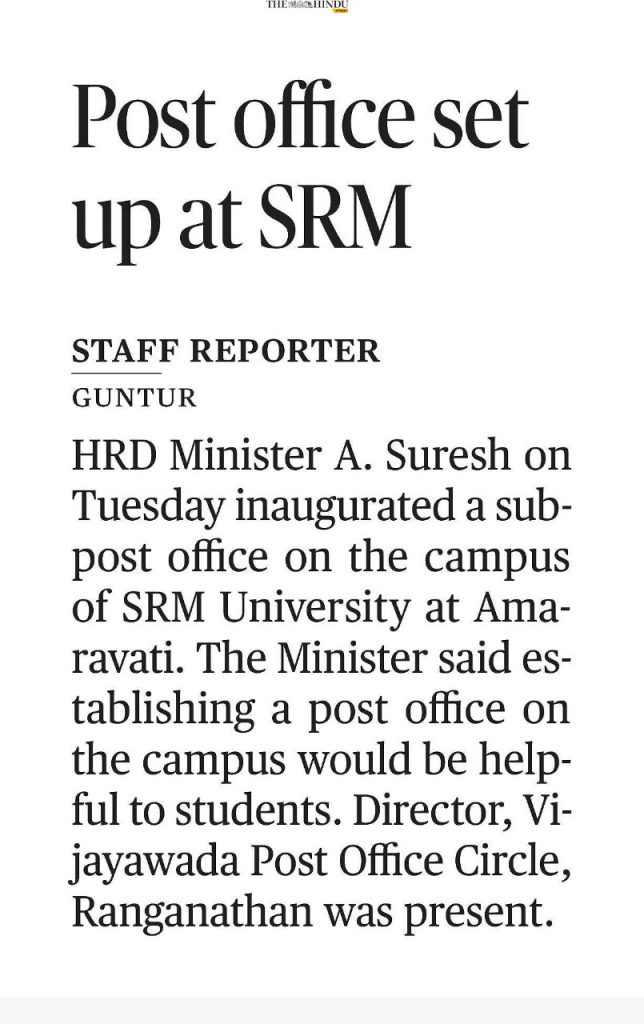
Deccan Chronicle Nov-18

Daily Pioneer Nov-18

Hans India Nov-18
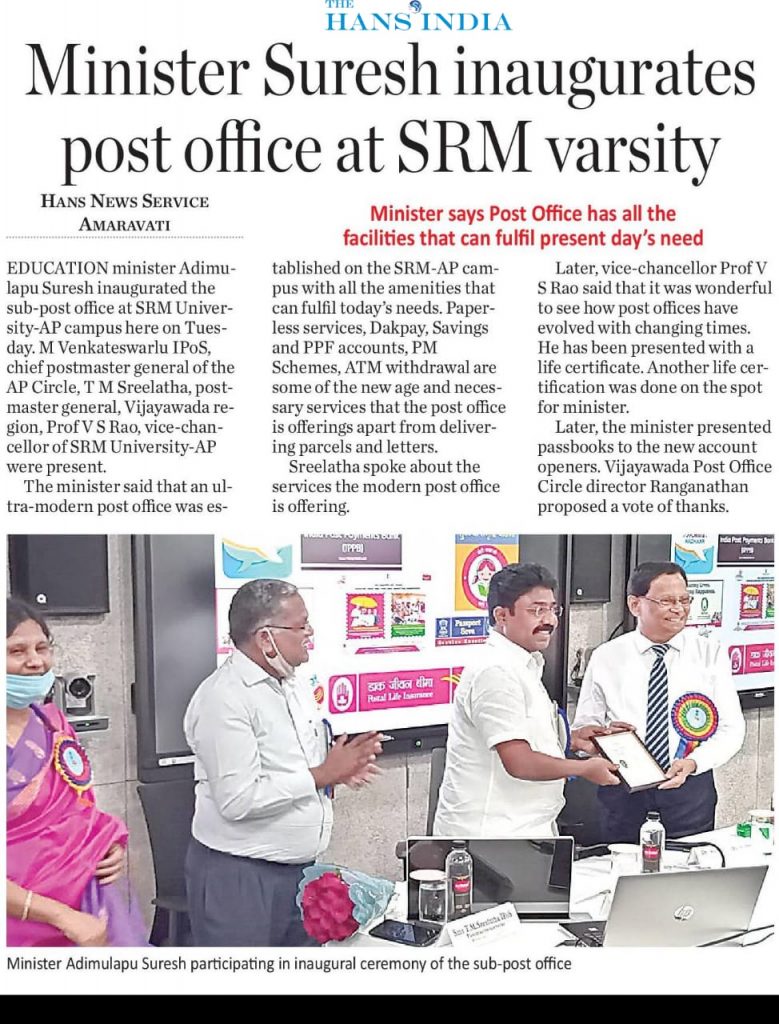
Eenadu Nov-18
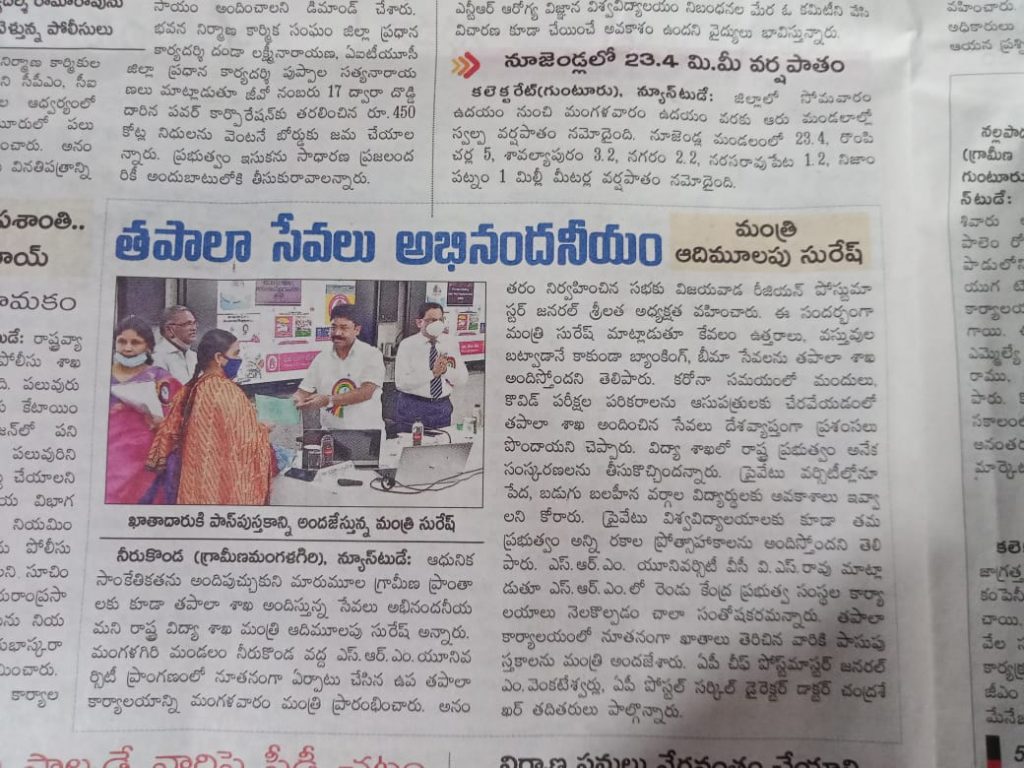
Sakshi Nov-18
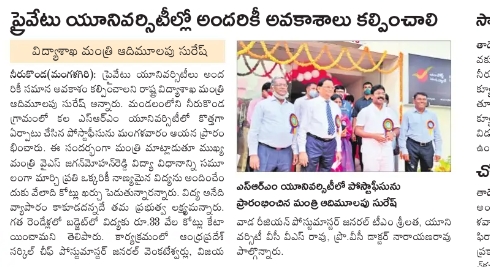
Andhra Jyothi Nov-18
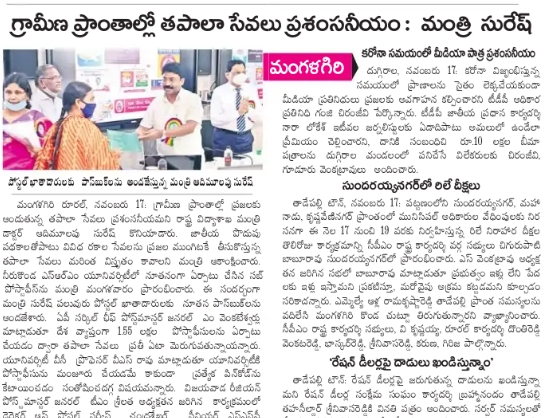
Andhra Prabha Nov-18
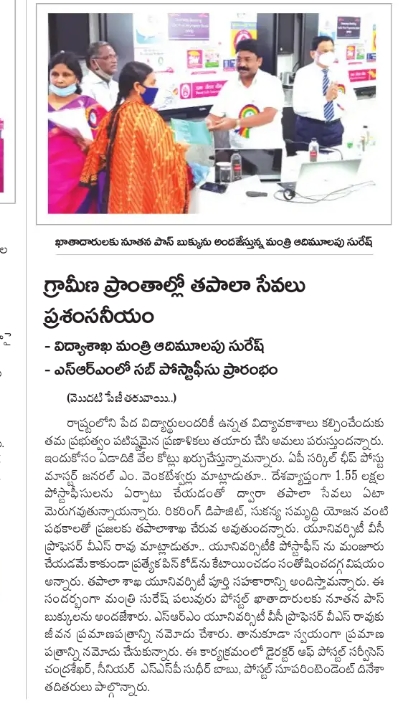
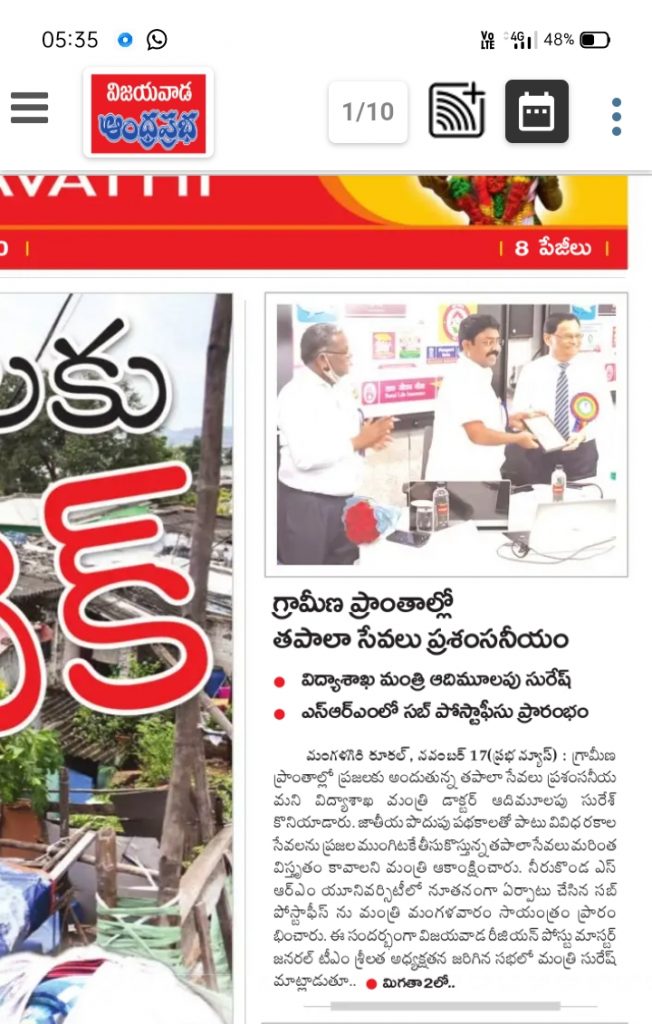
Sakshi Nov-18
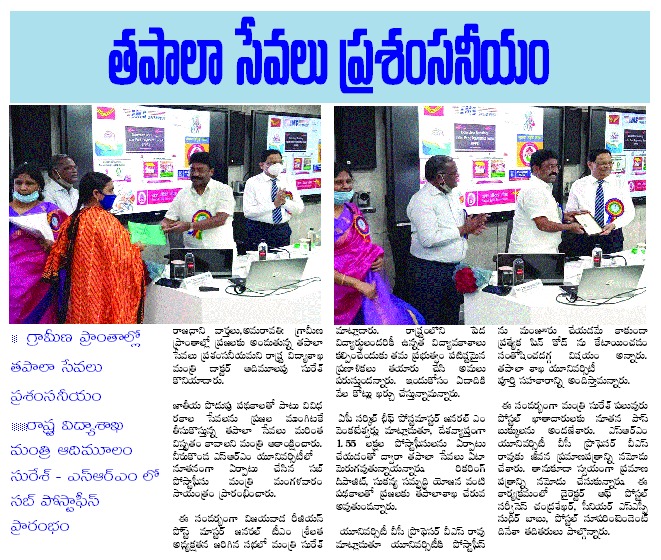
United News of India Nov-18
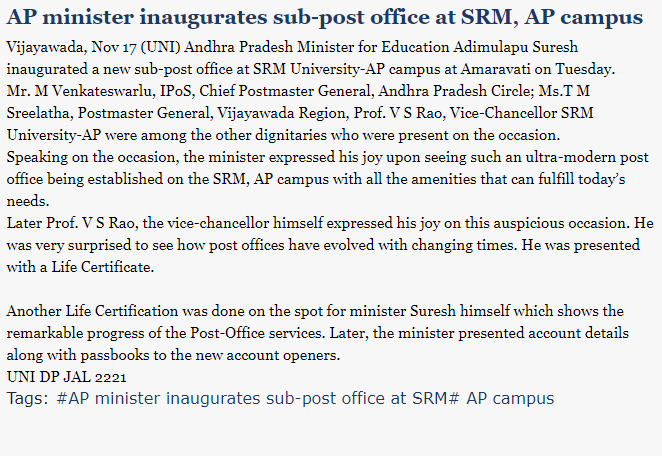
India Education Diary Nov-18
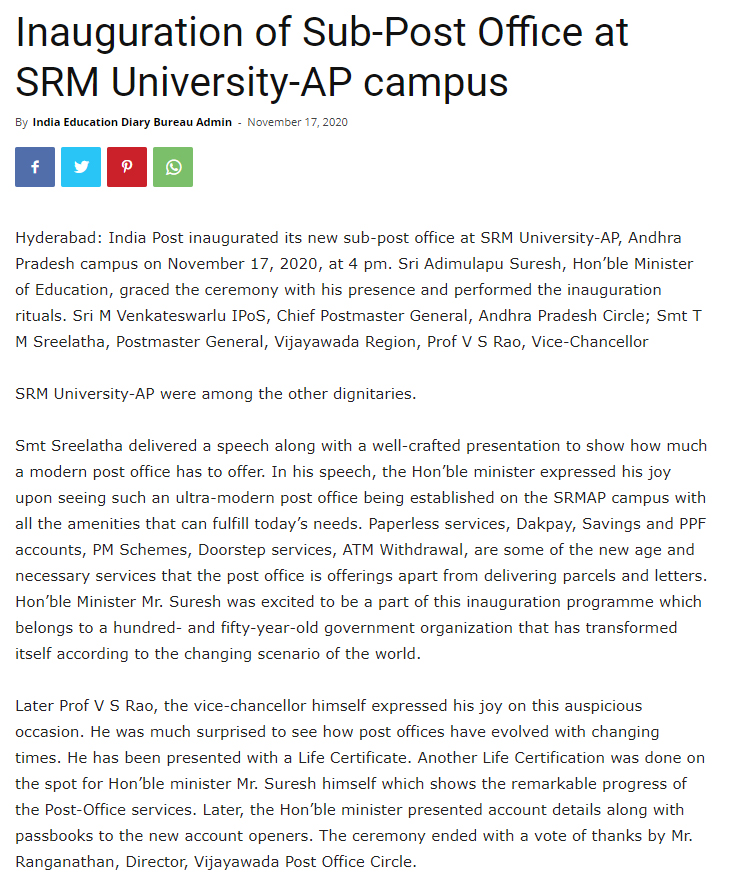
Higher Education Digest Nov-18
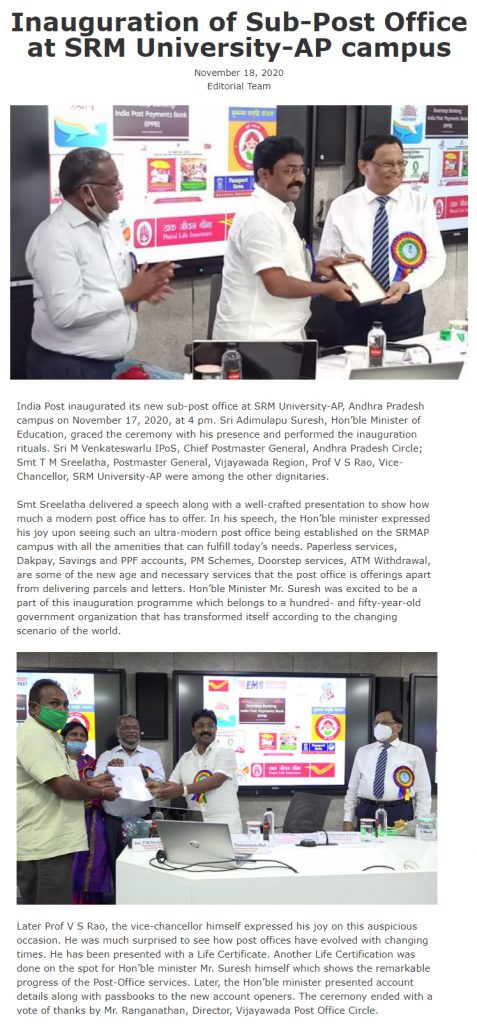
Media Bulletins Nov-18
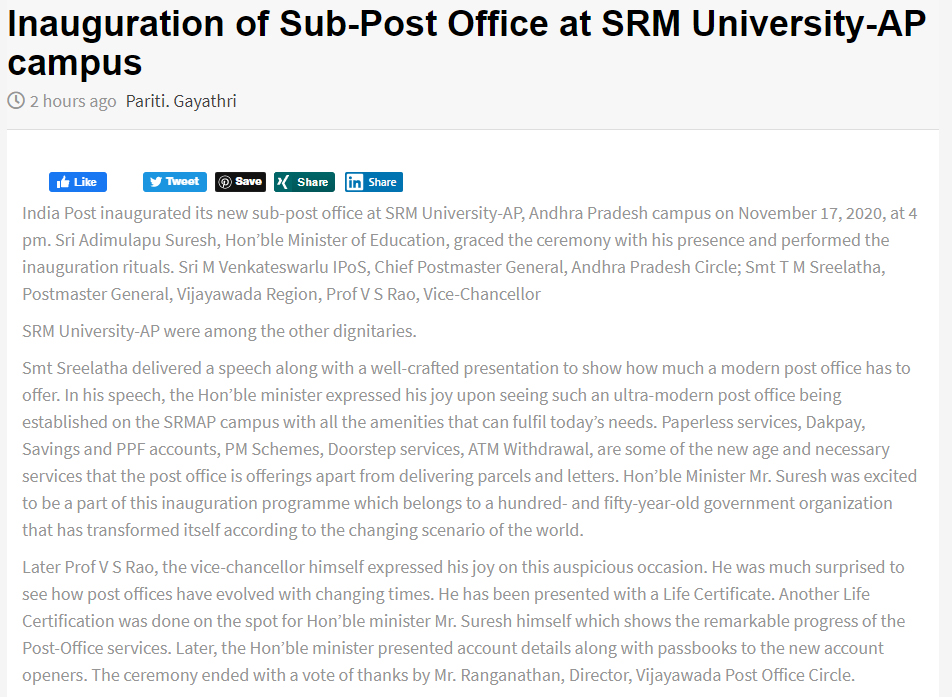
Global Green News Nov-18
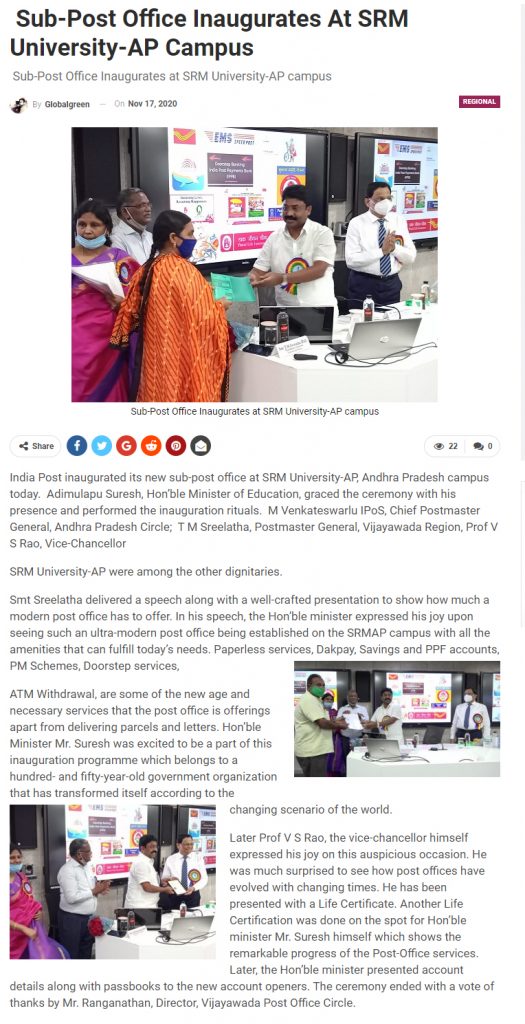
Business News This Week Nov-18
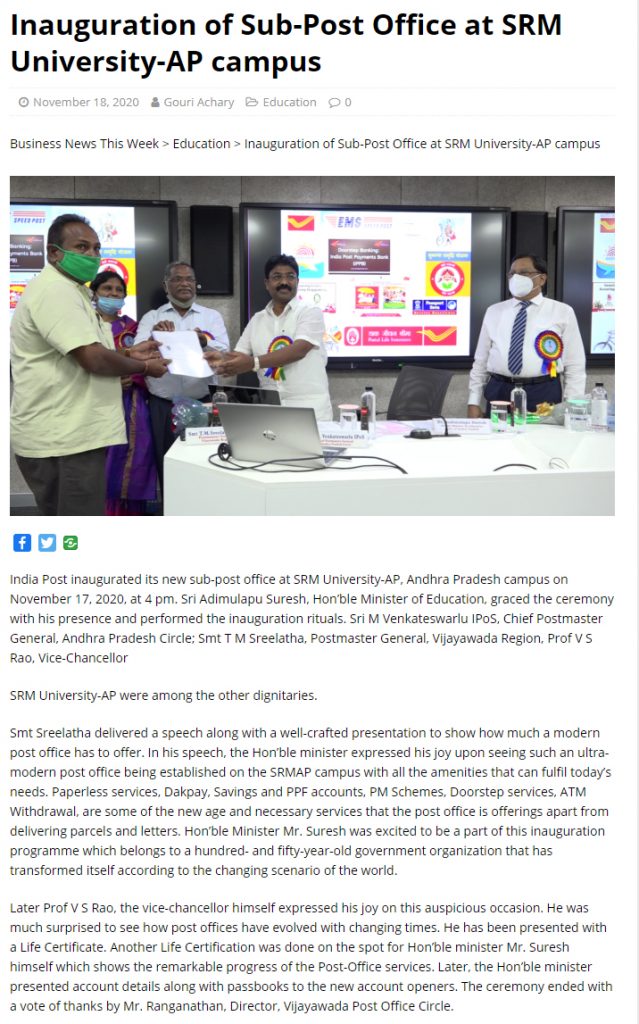
- Dr Lakhveer Singh’s impactful research proposes remedial strategies for mitigating phthalate pollution November 18, 2020
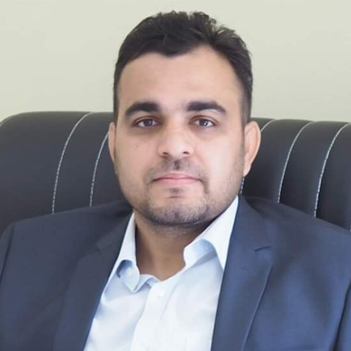 Dr Lakhveer Singh, Assistant Professor, Department of Environmental Science, SRM University-AP, Andhra Pradesh published an article titled “Remediation strategies for mitigation of phthalate pollution: Challenges and future perspectives” in the Journal of Hazardous Materials, with an Impact Factor of 9.03. In recent times, there has been an escalating concern over the risk of phthalate exposure leading to adverse effects on human health and the environment. Dr Lakhveer acknowledged the necessity of understanding the current status of phthalate pollution, their sources, exposure routes, and health impacts, along with understanding the remediation technologies for mitigating such issues.
Dr Lakhveer Singh, Assistant Professor, Department of Environmental Science, SRM University-AP, Andhra Pradesh published an article titled “Remediation strategies for mitigation of phthalate pollution: Challenges and future perspectives” in the Journal of Hazardous Materials, with an Impact Factor of 9.03. In recent times, there has been an escalating concern over the risk of phthalate exposure leading to adverse effects on human health and the environment. Dr Lakhveer acknowledged the necessity of understanding the current status of phthalate pollution, their sources, exposure routes, and health impacts, along with understanding the remediation technologies for mitigating such issues.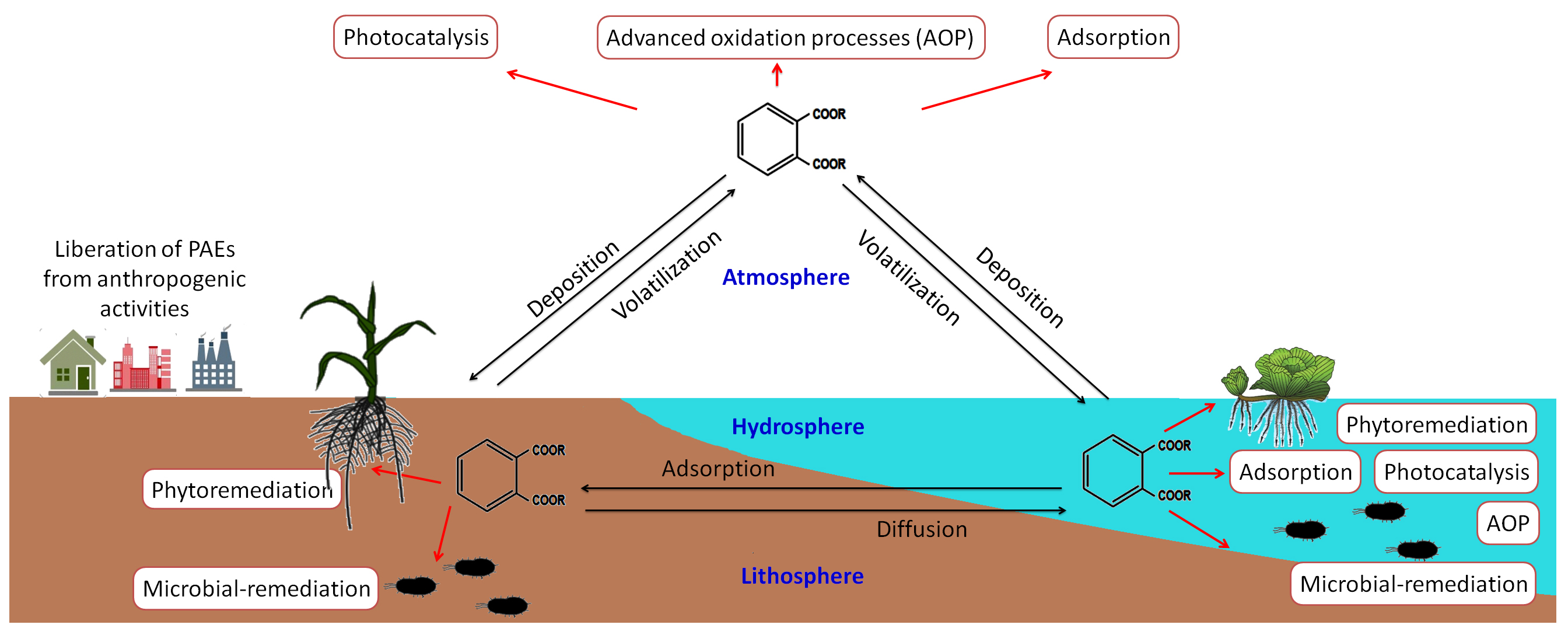 In this collaborative work between Indian Institute of Technology, Delhi, Jawaharlal Nehru University, and SRM AP, Dr Lakhveer enumerates the major phthalates in use today, shares insights on the ever-increasing data on health burdens posed by phthalates and simultaneously, highlights the recent advancements in research to alleviate phthalate contamination from the environment. Tracing their environmental fate, he addresses the growing health hazard concerns imposed by phthalates, along with focusing on understanding the different physical, chemical, and biological treatment of phthalates that are currently being used.
In this collaborative work between Indian Institute of Technology, Delhi, Jawaharlal Nehru University, and SRM AP, Dr Lakhveer enumerates the major phthalates in use today, shares insights on the ever-increasing data on health burdens posed by phthalates and simultaneously, highlights the recent advancements in research to alleviate phthalate contamination from the environment. Tracing their environmental fate, he addresses the growing health hazard concerns imposed by phthalates, along with focusing on understanding the different physical, chemical, and biological treatment of phthalates that are currently being used.Dr Lakhveer explains, “Depending on the degree and nature of contamination, PAEs can be eliminated from different environmental matrices via various available processes such as adsorption, coagulation-flocculation, microbial biodegradation, phytoremediation, photocatalysis, and advanced oxidation processes. However, the efficiency of all these processes depends on various factors including inherent Physico-chemical nature of phthalates, environmental factors, and technological sufficiency.” Thus, advancing his research work in the future, Dr Lakhveer will opt for a holistic approach to develop novel processes for the remediation.
Continue reading → - Dr Tousif Khan N elected as a Joint Secretary of ACDOS November 17, 2020
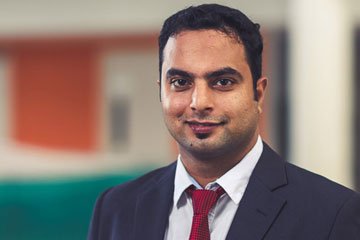 Dr Tousif Khan N, Head of the Department, Electrical and Electronics Engineering at SRM University-AP, Andhra Pradesh has been elected as a Joint Secretary (2020-2023) of the prestigious Automatic Control and Dynamic Optimization Society (ACDOS), Indian national member organization of International Federation of Automatic Control (IFAC). The objective of ACDOS is to promote automatic control and dynamic optimization fields in academia and industry across India. The society aims to host international conferences and technical workshops regularly in order to promote close interaction between industry professionals and academia. The society also participates in curriculum development for graduate and under-graduate studies in addition to facilitating productive research in this area. The society volunteers to honour eminent persons who excelled in this field in industry and academic circles.
Dr Tousif Khan N, Head of the Department, Electrical and Electronics Engineering at SRM University-AP, Andhra Pradesh has been elected as a Joint Secretary (2020-2023) of the prestigious Automatic Control and Dynamic Optimization Society (ACDOS), Indian national member organization of International Federation of Automatic Control (IFAC). The objective of ACDOS is to promote automatic control and dynamic optimization fields in academia and industry across India. The society aims to host international conferences and technical workshops regularly in order to promote close interaction between industry professionals and academia. The society also participates in curriculum development for graduate and under-graduate studies in addition to facilitating productive research in this area. The society volunteers to honour eminent persons who excelled in this field in industry and academic circles. Dr Tousif Khan N is an Assistant Professor in the Department of Electronics and Electrical Engineering at SRM University-AP, Andhra Pradesh. He has obtained his PhD from Indian Institute of Technology, Guwahati. Apart from performing his duties as a teacher, he is pursuing his research career in Control systems, Power Electronics and Optimization Techniques. The very young and talented professor has been honoured with several awards and recognitions for his pursuits in the domains of Teaching and Research. As a Joint Secretary of ACDOS, Dr Khan wishes to contribute further to the versatile worlds of Research and Academia.
The other members of ACDOS are eminent researchers and scientists such as Prof. Sukumar Mishra (IIT Delhi) as President, Dr Jayesh Barve (GE, Bangalore) as Vice-President and President-Elect, Dr Shaik Faruque Ali (IIT Madras) Vice-President, Prof Bidyadhar Subudhi (IIT Goa) as Vice-President, Dr Arnab Maity (IIT Bombay) as General Secretary, Dr S. N Omkar (IISc-Bangalore) as Treasurer and Prof Radhakant Padhi (IISc Bangalore) as Director of Operations.
To know more about ACDOS, please click the link: https://www.acdos.org/
Continue reading → - Prof S Chandrasekhar to deliver a talk during University Distinguished Lecture 04 November 17, 2020
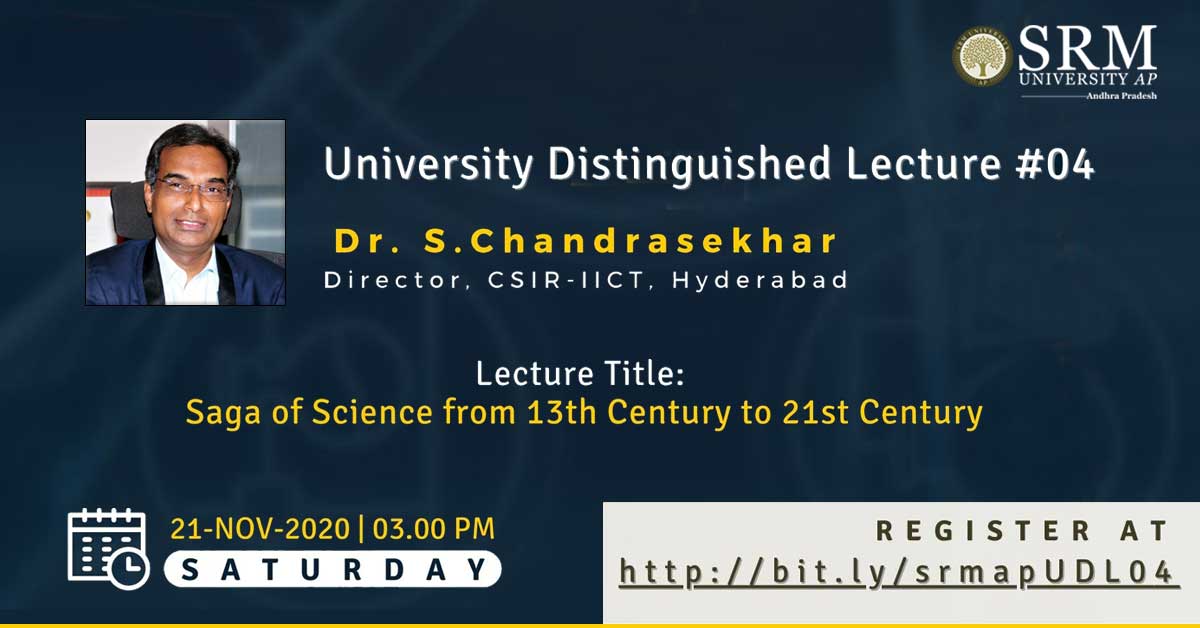 The fourth edition of the University Distinguished Lecture organized by SRM University-AP, Andhra Pradesh will be delivered by Prof S Chandrasekhar, Director, CSIR-Indian Institute of Chemical Technology, Hyderabad. On November 21, 2020, at 3 PM, the session on “Saga of Science from 13th Century to 21st Century” will be steered by the esteemed academician. Prof S Chandrasekhar joined CSIR-IICT as Scientist C and became the director in 2015. He has made significant contributions in diverse areas of organic chemistry with a special emphasis on chiral chemistry, total synthesis of biologically active natural products and pharmaceutical products. Further, he has received several accolades including the Eminent Scientist Award for contributions in the field of Chemistry from Telangana State Government in 2017, CNR Rao National Prize for Chemical Research 2012, CSIR Technology award 2014, and Infosys prize in Chemical sciences 2014 for his contributions to synthetic organic chemistry.
The fourth edition of the University Distinguished Lecture organized by SRM University-AP, Andhra Pradesh will be delivered by Prof S Chandrasekhar, Director, CSIR-Indian Institute of Chemical Technology, Hyderabad. On November 21, 2020, at 3 PM, the session on “Saga of Science from 13th Century to 21st Century” will be steered by the esteemed academician. Prof S Chandrasekhar joined CSIR-IICT as Scientist C and became the director in 2015. He has made significant contributions in diverse areas of organic chemistry with a special emphasis on chiral chemistry, total synthesis of biologically active natural products and pharmaceutical products. Further, he has received several accolades including the Eminent Scientist Award for contributions in the field of Chemistry from Telangana State Government in 2017, CNR Rao National Prize for Chemical Research 2012, CSIR Technology award 2014, and Infosys prize in Chemical sciences 2014 for his contributions to synthetic organic chemistry. Prof S Chandrasekhar has developed technologies for the synthesis of the latest anti-tuberculosis drug, bedaquiline; anti-tumor and abortive drug, misoprostol; anti-platelet molecule, beraprost; antidepressive compound, sertralin and drug for treatment of schizophrenia, asenapine. During his lecture, Prof S Chandrasekhar will frame a narrative of the knowledge explosion in terms of science and technology from the 13th to 21st century. Providing a historical perspective, he will describe the evolution of the technology base and the transformation of production and service activities.
Registration Link: https:bit.ly/srmapUDL04 (Registration Closed)
Continue reading →- Students excel in Technological Business Hackathon organized by AIESEC in Amaravati November 16, 2020
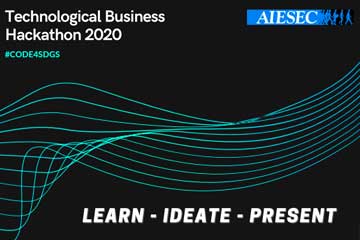 Students of SRM University-AP, Andhra Pradesh bagged the runners up award in the Technological Business Hackathon organized by AIESEC in Amaravati from October 30, 2020, till November 1, 2020. AIESEC is the world’s largest, global youth-run organization which acts as a platform for young minds to explore and develop their leadership potential. AIESEC works in accordance with the 17 Sustainable Development Goals (SDGs) devised by the United Nations and is recognized by UNESCO. Technological Business Hackathon was the first-ever virtual Hackathon hosted by AIESEC in Amaravati that aimed at developing innovative technological solutions for Sustainable Development Goals. It provided an opportunity for students to learn, ideate, solve, and present ideas on how to address some of the global challenges that the world is currently confronting.
Students of SRM University-AP, Andhra Pradesh bagged the runners up award in the Technological Business Hackathon organized by AIESEC in Amaravati from October 30, 2020, till November 1, 2020. AIESEC is the world’s largest, global youth-run organization which acts as a platform for young minds to explore and develop their leadership potential. AIESEC works in accordance with the 17 Sustainable Development Goals (SDGs) devised by the United Nations and is recognized by UNESCO. Technological Business Hackathon was the first-ever virtual Hackathon hosted by AIESEC in Amaravati that aimed at developing innovative technological solutions for Sustainable Development Goals. It provided an opportunity for students to learn, ideate, solve, and present ideas on how to address some of the global challenges that the world is currently confronting. 30 teams hailing from reputed colleges such as VIT AP, Christ University Bangalore, SRM AP, VVIT, KLU, Bennet, NID AP, NIT AP, JNTU Hyderabad, participated in the hackathon. The competition was split into a technical round and a business round, where 7 teams from SRM AP showcased their expertise in innovative technology. While two teams from SRM AP became the finalist, the second prize for the hackathon was awarded to one of them. The group developed a project inclined towards SDG 2: Zero Hunger, which involved the use of Hydroponics to grow fresh and sustainable food.
Continue reading →- Dr Shrabani Mukherjee November 12, 2020
- Dr Nimai Mishra analyzes approaches to stabilize photoluminescent nanocrystals November 12, 2020
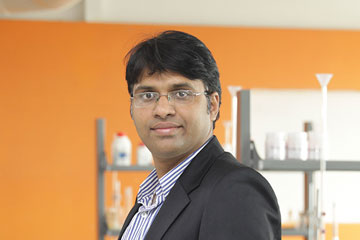 Dr Nimai Mishra, Assistant Professor, Department of Chemistry, SRM University-AP, Andhra Pradesh, along with his research group comprising of students pursuing PhD under him, Ms. V.G.Vasavi Dutt and Mr. Syed Akhil, have published a comprehensive mini review titled “Surface Passivation Strategies for Improving Photoluminescence and Stability of Cesium Lead Halide Perovskite Nanocrystals” in the Journal “ChemNanoMat” (Wiley-VCH) with an Impact Factor of 3.4.
Dr Nimai Mishra, Assistant Professor, Department of Chemistry, SRM University-AP, Andhra Pradesh, along with his research group comprising of students pursuing PhD under him, Ms. V.G.Vasavi Dutt and Mr. Syed Akhil, have published a comprehensive mini review titled “Surface Passivation Strategies for Improving Photoluminescence and Stability of Cesium Lead Halide Perovskite Nanocrystals” in the Journal “ChemNanoMat” (Wiley-VCH) with an Impact Factor of 3.4. 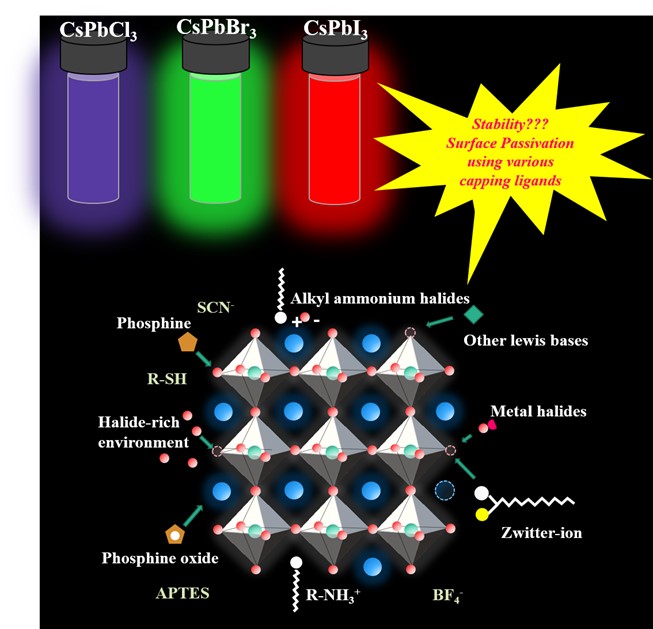 Cesium lead halide (CsPbX 3) perovskite nanocrystals (NCs) is emerging as an intriguing subject for the optoelectronics for its excellent optical properties and exceptional colour tunability. However, applicability of the materials become a major challenge due to their degenerative property. Consequently, researchers focus on developing various approaches to enhance the photoluminescence properties and stability of CsPbX 3 perovskite NCs. In the paper, Dr Mishras’s group reviews some of the promising approaches such as post‐synthetic modification, ligand exchange, and insitu addition.
Cesium lead halide (CsPbX 3) perovskite nanocrystals (NCs) is emerging as an intriguing subject for the optoelectronics for its excellent optical properties and exceptional colour tunability. However, applicability of the materials become a major challenge due to their degenerative property. Consequently, researchers focus on developing various approaches to enhance the photoluminescence properties and stability of CsPbX 3 perovskite NCs. In the paper, Dr Mishras’s group reviews some of the promising approaches such as post‐synthetic modification, ligand exchange, and insitu addition.Further, the strategies summarized in this paper will enable the production of high-quality nanocrystals having the potential to be used as active material in LED devices. In the future, Dr Mishra and his group plans on utilizing some of these surface passivation techniques to develop prototype LED devices using high quality nanocrystals.
Read the full paper: Please Click Here
Continue reading →- Car Designing Contest-2020 to challenge your imagination and intellect November 12, 2020
 Department of Student Affairs brings another exciting yet thought-provoking Car Designing Contest-2020 for the tech-savvy Generation-Z. An open challenge is given to the students to visualise their dream car and share it with the judges and the spectators. The competition is divided into three categories:
Department of Student Affairs brings another exciting yet thought-provoking Car Designing Contest-2020 for the tech-savvy Generation-Z. An open challenge is given to the students to visualise their dream car and share it with the judges and the spectators. The competition is divided into three categories:
1. Sketch of your dream car.
2. Write up on your dream car.
3. Model of your dream car.
All the students from the first year to the fourth year can participate in the contest. They can project their dream car using a designing software or simple on paper. Moreover, if someone has a flair for writing, they are most welcome to express it through the medium of 100-150 finely crafted words.
As William Blake said,” What is now proved was only imagined”. Being a movie buff or literature enthusiast, you must have come across many high-tech, beautifully designed cars. BATMOBILE, Bond cars, The car in Kingsman movie, Hotwheels cars are some meagre examples of that. Even in Bollywood movies like “Dhoom 3”, we have seen BMW bikes which can change to a speedboat when required. It is now your time to show us how vividly and tactfully you can imagine a car like that. Let your imagination run wild and come up with something extraordinary. Add wings to your dreams and bring out the technical side of you into the open and charge your brains.
So grab the opportunity and get noticed. Fill the google form and submit your files. For any further information or query, you can mail to venkata_sesha@srmap.edu.in.
To apply and submit: Click Here to fill out the google form
Last Date for submission: November 13, 2020
Announcement of the Winners: November 15, 2020
Continue reading →- SRM AP club Photography Society presents “Create or Re-Create”, a competition on the eve of Diwali November 11, 2020
 One of the most popular club of SRM University-AP, Andhra Pradesh, Photography Society organizes a photography competition “Create or Re-Create” on the Eve of Diwali to uphold the spirit of festivity. Students are urged to refine their skills and take captivating images to win a chance to showcase their creativity to the world. For participating in the contest, students are recommended to send their entries by taking a photograph of any child celebrating Diwali during the pandemic or of artifacts arranged creatively. The images will be evaluated, and the winner will be announced on November 15, 2020. Also, all the photographs will be shared as stories on the Instagram handle of Photography Society.
One of the most popular club of SRM University-AP, Andhra Pradesh, Photography Society organizes a photography competition “Create or Re-Create” on the Eve of Diwali to uphold the spirit of festivity. Students are urged to refine their skills and take captivating images to win a chance to showcase their creativity to the world. For participating in the contest, students are recommended to send their entries by taking a photograph of any child celebrating Diwali during the pandemic or of artifacts arranged creatively. The images will be evaluated, and the winner will be announced on November 15, 2020. Also, all the photographs will be shared as stories on the Instagram handle of Photography Society. Last date for sending your entries: November 13, 5:00 PM
Submission form: Click Here
Continue reading → - Students excel in Technological Business Hackathon organized by AIESEC in Amaravati November 16, 2020

